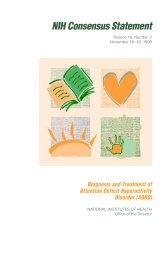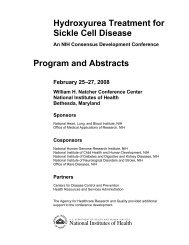Celiac Disease - NIH Consensus Development Program - National ...
Celiac Disease - NIH Consensus Development Program - National ...
Celiac Disease - NIH Consensus Development Program - National ...
You also want an ePaper? Increase the reach of your titles
YUMPU automatically turns print PDFs into web optimized ePapers that Google loves.
What Are the Prevalence and Incidence of <strong>Celiac</strong> <strong>Disease</strong>in High-Risk Populations: Patients With an AffectedFamily Member, Type 1 Diabetes, Iron-Deficiency Anemia,and Osteoporosis?Joseph A. Murray, M.D.OutlineThe presence of autoimmune conditions like insulin-dependent diabetes mellitus (DM), afamily history of celiac disease (CD), or dermatitis herpetiformis may increase the risk ofcoexisting CD. The prevalence of CD may be increased in certain patient groups including thefollowing: osteoporosis or low bone mass, or iron-deficiency anemia.Family History of CD and Dermatitis HerpetiformisMany early case reports documented the occurrence of CD in siblings, identical twins,parent and child pairs, as well as more extended kindreds. At least 20 percent of index cases willhave an affected family member if screening is done. The exact degree of increased risk forspecific family members has not been reliably ascertained but estimates have been made basedon screening studies undertaken at one point in time. Identical twins have a 75–100 percentconcordance rate for the disease. Siblings are at the next highest risk at 7–20 percentconcordance rate. It has been suggested that if siblings share the same HLA disease riskhaplotype, their risk approaches 40 percent. It is less so for parents or children of the proband.Most of these studies were in homogenous populations where the background risk for CD washigh. A recent multicenter study in the U.S. identified a rate of 4–5 percent of first-degreerelatives had CD based on endomysial antibody testing, a rate significantly greater than the ratein the not-at-risk individuals.These studies have based their risk estimations on the numbers of relatives that werescreened, not necessarily the number of first-degree relatives. Many of these studies are subjectto the selection bias of family members coming forward or agreeing to screening. Additionally,there often is incomplete followup of family members to determine if the screening at one pointin time is an adequate estimation of the risk over time. Not all studies were so positive. Two of100 first-degree family members underwent biopsy and only 2 had CD. Five others appeared tohave transient changes. Occasional cases of progression to CD have been reported in a few casesinitially negative for CD. In our ongoing community study, 10 percent of tested first-degreerelatives are found to have undiagnosed CD. A further 2 percent had possible CD with subtlehistopathological changes on intestinal biopsies. Almost as many family members werediagnosed clinically for CD via screening, usually because of a heightened awareness of the riskin a symptomatic relative. Serological testing detected most, but not all, screened-found patientswith CD, however 4/41 patients were found to have CD based on biopsy alone. This was due tothe protocol that included biopsying symptomatic family members who had the at-risk HLA typedespite negative serology. While most screen-found patients had little or no symptoms,compliance with a gluten-free diet was good.49







